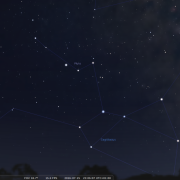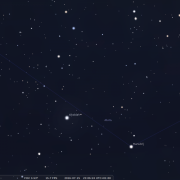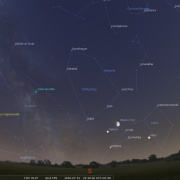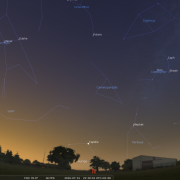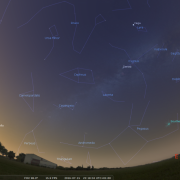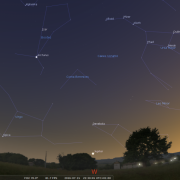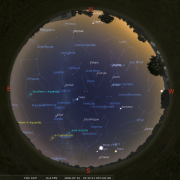In this month's Sky Notes:
Planetary Skylights
Three major planets are now visible in the late evening sky, Jupiter, Mars and Saturn.

 Jupiter continues to dominate the western sky as twilights deepens, although by the end of July it is only visible for a short while before setting. Observations are always fascinating: the location of the Galilean moons, the banding across the disk, and when on view, the size and colour of the great red spot, all add interest through the eyepiece. From the 12-14th Jupiter resides quite close to sigma Leonis, whilst on the 13th Europa passes in front of the Jovian disk with Ganymede on one side and Io and Callisto on the other. Observe around 22:30h. Our Moon is closest on the 8th and 9th
Jupiter continues to dominate the western sky as twilights deepens, although by the end of July it is only visible for a short while before setting. Observations are always fascinating: the location of the Galilean moons, the banding across the disk, and when on view, the size and colour of the great red spot, all add interest through the eyepiece. From the 12-14th Jupiter resides quite close to sigma Leonis, whilst on the 13th Europa passes in front of the Jovian disk with Ganymede on one side and Io and Callisto on the other. Observe around 22:30h. Our Moon is closest on the 8th and 9th
 Mars is on show low to the south, a conspicuous ochre beacon, gradually diminishing in brightness as we head through July. Do not confuse Antares (chief star in Scorpius) which resides lower left and is also of orange hue with Mars. It’s been a strange opposition period for Mars. Quite often when Mars reaches opposition the planet undergoes periods of turbulent dust storms, rendering much of the surface invisible to observation... annoyingly. This time around, a combination of factors has conspired to inhibit observations from Earth, particularly from the UK. The light nights, the position of Mars low on the ecliptic and especially the atrocious weather, all seemed to have restricted views through the scope to a pitiful level... annoyingly. Hopefully matters will improve with regard on the weather front... won’t it? The moon passes by Mars on 14th–16th.
Mars is on show low to the south, a conspicuous ochre beacon, gradually diminishing in brightness as we head through July. Do not confuse Antares (chief star in Scorpius) which resides lower left and is also of orange hue with Mars. It’s been a strange opposition period for Mars. Quite often when Mars reaches opposition the planet undergoes periods of turbulent dust storms, rendering much of the surface invisible to observation... annoyingly. This time around, a combination of factors has conspired to inhibit observations from Earth, particularly from the UK. The light nights, the position of Mars low on the ecliptic and especially the atrocious weather, all seemed to have restricted views through the scope to a pitiful level... annoyingly. Hopefully matters will improve with regard on the weather front... won’t it? The moon passes by Mars on 14th–16th.
 Saturn also resides low to the south, to the left of Mars, and having reached opposition last month remains a conspicuous object, its pearly white lustre contrasting nicely with ‘ruddy’ Mars. A telescope is required to see the ring system, look for the Cassini gap in the rings as well as several moons nearby. Titan, Saturn’s largest moon appears as a bright speck close by, orbiting anticlockwise twice a month. Our Moon resides above Saturn on the 16th.
Saturn also resides low to the south, to the left of Mars, and having reached opposition last month remains a conspicuous object, its pearly white lustre contrasting nicely with ‘ruddy’ Mars. A telescope is required to see the ring system, look for the Cassini gap in the rings as well as several moons nearby. Titan, Saturn’s largest moon appears as a bright speck close by, orbiting anticlockwise twice a month. Our Moon resides above Saturn on the 16th.
 Pluto reaches opposition on July 7th, but at magnitude +14, you will definitely require quite a large scope (10-inch plus) to identify it for certain. Pluto resides in the ‘teaspoon’ asterism which adjoins the ‘Teapot’ asterism in Sagittarius located not far above the south horizon around midnight.
Pluto reaches opposition on July 7th, but at magnitude +14, you will definitely require quite a large scope (10-inch plus) to identify it for certain. Pluto resides in the ‘teaspoon’ asterism which adjoins the ‘Teapot’ asterism in Sagittarius located not far above the south horizon around midnight.
|
General location of Pluto in
Sagittarius on 25-Jul-2016 at 23:00h
|
Teapot and Teaspoon |
Meteor Showers

A number of lesser meteor showers occur during July.
- The Capri-Cornids have 3 maxima, July 8, 15, and 26, but all have Zenith hourly rates (ZHR) of only half a dozen, the same as sporadic rates.
- The Alpha-Cygnids peak on July 21st, again rates are barely more than sporadic levels. Cygnus is well placed high in the SSE by midnight, but strong moonlight will interfere.
- The Delta-Aquarids are a little more prolific and peak on July 30th with a ZHR approaching 20. The light conditions outside do however restrict observations to a period between midnight and 02:30h.
July 2016 Sky Charts
Click each image to see a full-size Sky Chart:
|
Looking South
Mid-July - 22:30h |
Looking North |
|
Looking East
Mid-July - 22:15h |
Looking West
Mid-July - 22:30h |
|
|
|
|
Overview
9th-July - 22:30h |
|
Additional Image Credits:
- Planets and Comets where not otherwise mentioned: NASA
- Sky Charts: Stellarium Software
- Log in to post comments

